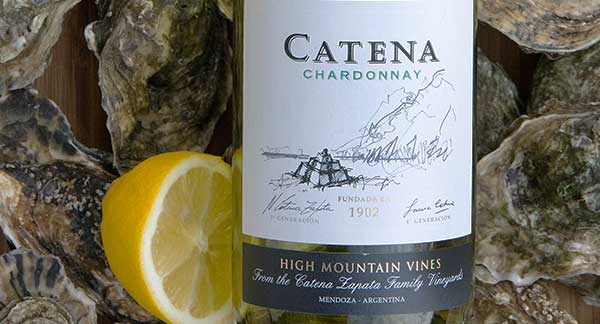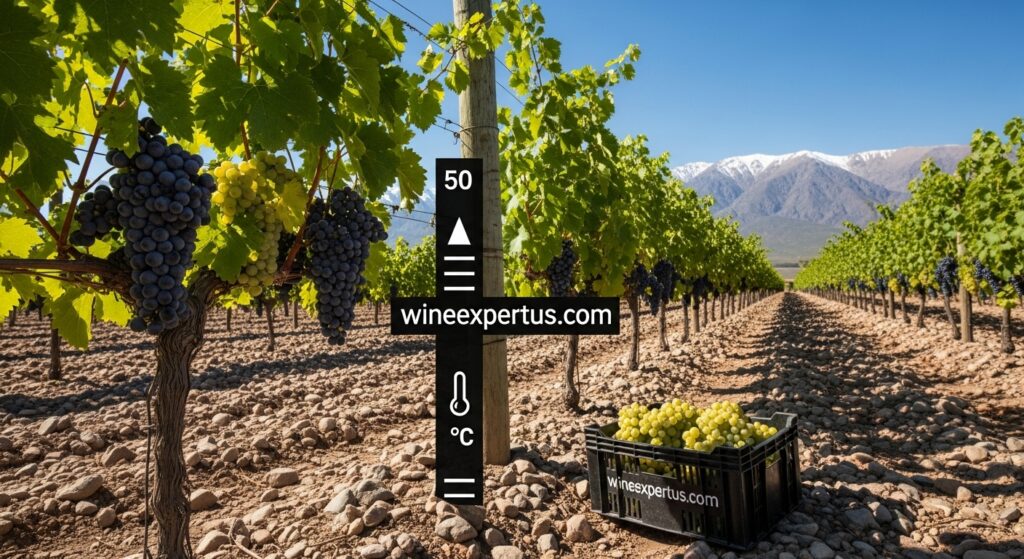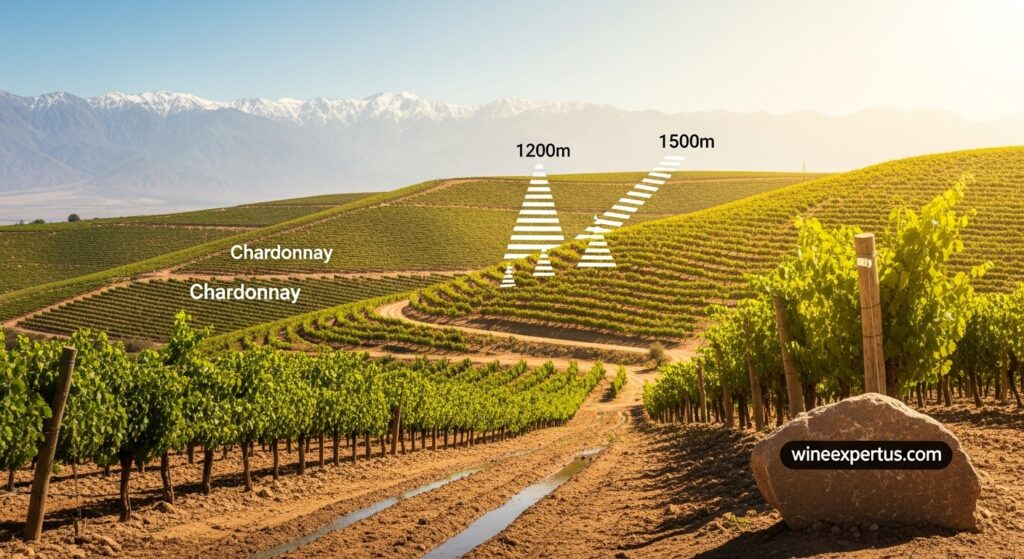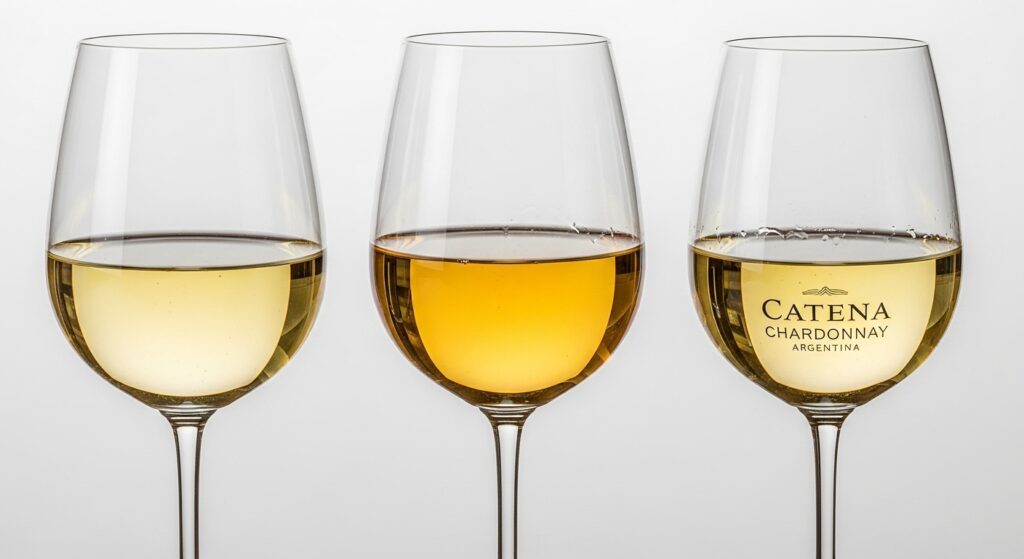Catena Chardonnay – A Beacon of Argentine Wine

Your Definitive Catena Chardonnay Review Starts Here
Hey wine lovers, Lily Tran here! As a WSET Level 3 expert and, admittedly, a bit of a wine-obsessed SEO strategist, I’m thrilled to guide you through another captivating corner of the wine world. This Catena Chardonnay review will be your comprehensive guide to understanding this iconic Argentine wine.
When you think Chardonnay, do Napa Valley’s buttery giants or Burgundy’s elegant classics come to mind? You’re not alone. But trust me, once you experience Catena Chardonnay, your world of white wine might just get a little bigger. This isn’t just a bottle of wine; it’s a testament to the unique high-altitude terroir of Mendoza, the relentless pursuit of excellence by a pioneering family, and a wine that beautifully bridges the gap between Old World elegance and New World fruit expression. Having tasted countless Chardonnays from all corners of the globe, I can tell you that Catena Chardonnay holds a special place in my cellar – and my heart. It’s complex, refreshing, and utterly captivating.
Meet Catena Zapata: A Legacy of Innovation
Before we swirl and sip, let’s explore the roots of this remarkable wine – the story of Catena Zapata. More than just a winery, it’s a living legend in Argentine viticulture.
The Catena Family Saga
Who is behind Catena Zapata? The Catena Zapata story began in 1902 when Nicola Catena, an Italian immigrant from Marche, planted his first Malbec vines in Mendoza. Like many immigrants, he brought with him a dream of a better life and an unwavering belief in the potential of this new land. However, it was his grandson, Nicolás Catena Zapata, who truly revolutionized Argentine wine in the 1980s.
Nicolás challenged the status quo, tirelessly experimenting and searching for ways to elevate Argentine wine quality to international standards. He was a visionary who pioneered high-altitude vineyard planting – a concept many considered audacious at the time. Yet, these daring high-altitude vineyards became the cornerstone of Catena’s phenomenal success, especially for their Chardonnay.
Today, Nicolás’s daughter, Laura Catena – a physician by training and a passionate advocate for Argentine wine – continues her father’s legacy. Laura, with her unique blend of scientific rigor and profound love for wine, has propelled Catena Zapata to new heights, solidifying its position as one of the world’s leading wine producers.
The “Knowledge of the Terroir” Philosophy

What is Catena Zapata’s core philosophy? At the heart of Catena Zapata’s winemaking lies their profound “Knowledge of the Terroir.” They believe the key to crafting great wines lies in an intimate understanding of every patch of land, every slope, every layer of soil and rock. This isn’t just a marketing slogan; it’s a meticulously scientific and painstaking approach.
For decades, they’ve invested heavily in researching the soils, climate, and microclimates of their vineyards. From analyzing diverse soil types (rocky, stony, clay, sandy) to meticulously measuring temperature, rainfall, and sun intensity at varying altitudes, Catena Zapata has built an unparalleled reservoir of knowledge about Mendoza’s terroir.
This deep understanding allows them to select the perfect grape varietal for each tiny parcel of land, apply optimal viticultural techniques, and make precise winemaking decisions. For Catena Chardonnay, this means identifying and cultivating their vines in the highest-altitude vineyards where Chardonnay can truly express its full potential.
Chardonnay Unpacked: From Burgundy to Mendoza
Chardonnay is one of the world’s most popular and versatile white grape varieties. But what makes it so appealing, and how has it adapted to the Argentine landscape?
What Makes Chardonnay Special?

Why is Chardonnay so popular? Chardonnay is often called the “winemaker’s grape” because it beautifully expresses both its terroir and the winemaker’s craft. It’s a “chameleon grape,” capable of producing a wide spectrum of wine styles, from crisp, unoaked versions with green apple and citrus notes to rich, complex wines with vanilla, butter, and toast nuances when aged in oak.
- Taste Profile: Chardonnay typically offers medium to high acidity, with a body ranging from medium to full-bodied.
- Aroma Profile:
- Unoaked: Green apple, pear, lemon, grapefruit, and sometimes mineral notes like wet stone or chalk. Think of a bright Chablis from France, or perhaps a lean, crisp Chardonnay from Oregon’s Willamette Valley.
- Oaked: Vanilla, butter, cream, toast, hazelnut, pineapple, and mango. This is the style often associated with California Chardonnays from regions like Napa Valley or Sonoma Coast.
- Climate Adaptability: Chardonnay thrives in various climates, but it truly shines in cool to moderate regions where it can retain its natural acidity and develop complex flavors.
Chardonnay Thrives in Argentina

How does Chardonnay perform in Argentina? While Argentina is globally renowned for its Malbec, it also produces some extraordinary Chardonnays, and Catena Chardonnay is a shining example.
Chardonnay in Mendoza benefits from a unique confluence of factors:
- High Altitude: This is the most critical factor. Catena’s Chardonnay vineyards are typically situated at elevations ranging from 3,000 to 5,000 feet (about 900 to 1,500 meters) above sea level. This elevation provides warm days but significantly cooler nights, allowing the grapes to ripen slowly and evenly, preserving crucial natural acidity for balance and aging potential.
- Intense Sunlight: Despite the high altitude, Mendoza receives abundant sunshine, which helps the grapes fully develop their flavors and sugars.
- Rocky Soils: Mendoza’s soils are often alluvial, stony, and gravelly, providing excellent drainage. This forces the vine roots to dig deep, absorbing more minerals and producing grapes with concentrated flavors.
These conditions allow Mendoza Chardonnays to showcase a beautiful interplay of ripe tropical fruit flavors, refreshing minerality, and vibrant acidity. When oaked, they develop additional layers of vanilla, butter, and nutty notes, resulting in a full-bodied yet refined style.
Mendoza’s Unique Terroir: The High-Altitude Advantage
Mendoza is the vibrant heart of Argentina’s wine industry, and it’s where Catena Chardonnay finds its spiritual home. To truly appreciate this wine, we need to delve into Mendoza’s distinctive terroir.
Altitude and Climate: The Key to Freshness

What makes Mendoza’s high-altitude vineyards special for Chardonnay? As I’ve emphasized, altitude is a game-changer for Catena Chardonnay.
- High-Altitude Vineyards: Catena sources its Chardonnay grapes primarily from high-elevation vineyards like Gualtallary, Eugenio Bustos, and El Cepillo within the Uco Valley. These sites soar to impressive heights, ranging from approximately 3,600 feet (1,100 meters) to nearly 5,000 feet (1,500 meters) above sea level.
- Impact of Altitude:
- Extreme Diurnal Range: Mendoza experiences warm days, but due to the elevation, nighttime temperatures drop dramatically. This significant temperature swing (diurnal range) allows the grapes to “rest” at night, preserving natural acidity and extending the ripening period, resulting in complex flavors without over-ripeness. This is a stark contrast to some warmer, lower-elevation regions.
- Intense Sunlight: Higher altitudes mean stronger UV radiation. This encourages thicker grape skins and a greater accumulation of compounds responsible for color and flavor.
- Dry Air: The thinner, drier air at high altitudes significantly reduces the risk of fungal diseases and mildew, promoting healthier vines and often allowing for more sustainable viticulture.
- Impact of Altitude:
- Arid Climate & Andean Water Source: Mendoza is essentially a desert, receiving very little rainfall. The primary water source for vineyards comes from the melting snow of the majestic Andes Mountains, channeled through an intricate irrigation system. This allows growers precise control over water allocation, leading to high-quality, concentrated grapes.
Soils: A Tapestry of Minerals
What kind of soils does Catena Chardonnay grow in? Mendoza’s soils are incredibly diverse and play a crucial role in shaping Catena Chardonnay’s flavor.
- Alluvial Soils: Most vineyards in Mendoza are characterized by alluvial soils, formed over millennia by the deposition of rocks, gravel, sand, and clay carried down from the Andes by ancient glaciers and rivers.
- Soil Composition: Catena’s extensive soil research has uncovered remarkable diversity even within small vineyard plots.
- Stones and Limestone: Notably, some vineyards in Gualtallary, from which Catena sources grapes for its more premium Chardonnays, contain significant amounts of stones and limestone. Limestone is renowned for imparting elegance, minerality, and freshness to Chardonnay, similar to what you’d find in the best Burgundies.
- Excellent Drainage: The stony soil structure ensures excellent drainage, forcing vine roots to penetrate deep into the earth in search of water and nutrients. This results in robust, healthy vines and grapes with concentrated flavors.
The synergy of high elevation, a wide diurnal range, intense sunlight, dry air, and diverse soils creates a unique terroir for Chardonnay in Mendoza, giving Catena Chardonnay a distinct style unlike any other Chardonnay in the world.
Crafting Catena Chardonnay: From Vine to Bottle
Transforming Mendoza’s exquisite Chardonnay grapes into world-class wine requires a meticulous winemaking process that blends tradition with cutting-edge techniques.
Harvesting & Selection

How are Catena’s Chardonnay grapes harvested? Catena’s Chardonnay grapes are typically harvested by hand during the cool hours of the night or early morning. This is absolutely critical to keep the grapes cool, preserving their delicate aromas, flavors, and crucial acidity. Cool temperatures prevent premature oxidation and maintain that crisp freshness.
Once harvested, the grapes undergo rigorous selection. Only the finest, most pristine clusters are chosen to ensure optimal quality for the wine. This may even involve advanced optical sorting machines to remove any undesirable berries.
Fermentation & Aging
How is Catena Chardonnay fermented and aged? This is where the magic truly happens, where grape juice transforms into exquisite wine. Catena employs a variety of methods to build complexity into their Chardonnay.
- Whole Cluster Pressing: Some batches may undergo whole cluster pressing (without destemming), a technique used to minimize tannin extraction and contribute finesse and freshness to the juice.
- Fermentation:
- Stainless Steel Tanks: A portion of the grapes might be fermented in temperature-controlled stainless steel tanks. This method helps preserve the pure fruit character, crispness, and minerality of the Chardonnay.
- Oak Barrels: A significant portion of Catena Chardonnay is fermented in French oak barrels. Fermenting in oak not only imparts vanilla and toasted notes but also enhances the wine’s structure, complexity, and aging potential.
- Indigenous Yeasts: Catena Zapata is known for experimenting with and utilizing indigenous yeasts found naturally in their vineyards. This allows the wine to more authentically express its terroir, contributing unique and nuanced flavors that commercial yeasts might not.
- Malolactic Fermentation (MLF): After alcoholic fermentation, most Catena Chardonnay undergoes partial or full malolactic fermentation. This process converts tart malic acid (think green apple) into softer lactic acid (think milk or butter), giving the wine a creamier, rounder mouthfeel and reducing harsh acidity. The extent of MLF is carefully controlled to achieve the desired balance.
- Lees Stirring (Bâtonnage): After fermentation, the wine often ages on its lees – the dead yeast cells remaining in the barrel. Regular stirring of these lees (bâtonnage) adds richness, body, and complex flavors of toasted bread, nuts, and cream to the wine. It’s a labor-intensive technique but highly effective for enhancing Chardonnay quality.
- Aging Period: Catena Chardonnay typically ages in French oak barrels for a specific period (often 6 to 12 months, depending on the vintage and specific bottling), with a certain percentage of new oak to further integrate complex flavors.
The Art of Blending
How does blending contribute to Catena Chardonnay’s complexity? Like a masterful conductor, Catena Zapata’s winemakers meticulously blend wines from different parcels, different vineyards, and wines aged with varying techniques to craft the final, harmonious product. The goal is to achieve an ideal balance of freshness, fruit expression, structure, complexity, and aging potential. This process demands immense finesse, experience, and a discerning palate to recognize the potential of each component.
Tasting Notes: A Deep Dive into Catena Chardonnay’s Flavor Profile
This is my favorite part – truly exploring what’s in your glass of Catena Chardonnay. As a WSET Level 3 expert, I’ll provide a detailed analysis.

The vibrant beauty and unique flavor of Catena Chardonnay, reflecting Mendoza’s majestic terroir.
Color
What does Catena Chardonnay look like in the glass? When you pour Catena Chardonnay, you’ll notice a shimmering, brilliant straw-gold color. Depending on the vintage and age, it might have faint green or amber hints. It’s a bright, inviting hue that suggests freshness while hinting at richness.
Aroma Profile
What aromas can I expect from Catena Chardonnay? This is where Catena Chardonnay truly shines, offering a multi-layered bouquet of aromas, from fresh fruit to elegant oak.
- Fruit Aromas:
- Fresh/Citrus: When young, you’ll clearly perceive notes of green apple, crisp pear, lemon zest, and grapefruit, contributing to its vibrant, energetic character.
- Tropical Fruits: As the wine opens up or in riper vintages, you’ll discover alluring tropical fruit notes like ripe pineapple, juicy mango, and a hint of banana. This is typical of Chardonnay grown in sunny regions where grapes achieve full ripeness.
- Stone Fruits: Often, there are subtle hints of white peach or apricot, adding a delicate sweetness and softness.
- Yeast/Oaking Influences:
- Vanilla & Toast: These are classic notes derived from oak barrel aging. Vanilla typically appears first, followed by gentle toasted bread, or sometimes a subtle smoky quality.
- Butter/Cream: Thanks to malolactic fermentation, you’ll detect creamy butter, rich cream, or even a hint of Greek yogurt, contributing to a round, soft mouthfeel.
- Nutty/Toasted Almond: Occasionally, you might encounter notes of hazelnut, cashew, or toasted almond, especially in wines with longer lees aging.
- Mineral Notes: This is the “voice” of Mendoza’s unique terroir. You might smell wet stone, chalk, or flint, adding complexity and a refreshing lift to the aromatic profile.
- Floral Notes: Delicate white floral notes like honeysuckle or orange blossom can emerge, particularly in younger vintages.
Palate
What does Catena Chardonnay taste like? The palate of Catena Chardonnay typically reveals a remarkable balance between refreshing acidity and generous body.
- Acidity: Catena Chardonnay consistently exhibits medium to high acidity. This acidity is crucial for balancing the richness of the fruit and oak flavors, providing a refreshing lift and a long, clean finish. This is a hallmark of high-altitude Chardonnay.
- Body: This wine is typically medium to full-bodied. It’s not overly heavy but maintains a graceful presence, thanks to its excellent acidity.
- Mouthfeel: Smooth, creamy, yet still fresh and clean. This texture is a beautiful result of both malolactic fermentation and lees aging.
- Flavor on the Palate: The aromas you perceive on the nose will largely translate to the palate, often featuring pineapple, lemon, peach, and apple, alongside vanilla, butter, and a touch of toasted bread. The mineral notes are also distinctly present, lending sophistication and depth.
- Alcohol: Usually in the medium to high range (around 13.5% – 14.5% ABV), but it’s well-integrated, avoiding any hot or aggressive sensation.
Finish
How does Catena Chardonnay finish? The finish of Catena Chardonnay is typically long, complex, and invigorating. You’ll experience a lingering combination of ripe fruit, a touch of minerality, and subtle oak spice. The finish is clean and invites another sip.
Exploring Different Vintages
Do Catena Chardonnay vintages taste different? Absolutely! Each vintage of Catena Chardonnay will exhibit subtle variations due to differences in that year’s climatic conditions.
- Cooler Vintages: Tend to display more green fruit characteristics, crisper acidity, and a more elegant, perhaps leaner, structure. Mineral notes might be more pronounced.
- Warmer Vintages: Will lean towards riper tropical fruit notes, a fuller body, and potentially more overt oak influence. However, thanks to the high-altitude vineyards, Catena still manages to retain freshness even in warmer years.
My advice as a WSET expert? If you get the chance, try different vintages. It’s fascinating to discover the subtle nuances that nature and the winemaker’s hand create.
Food Pairing Perfection: Elevating Your Experience
One of the greatest joys of wine is pairing it with the right food. With Catena Chardonnay’s complexity and balance, there are many delightful options.
Chardonnay Pairing Principles
What are the basic rules for pairing food with Chardonnay? When pairing food with Chardonnay, always consider the wine’s style:
- Unoaked Chardonnay: Best with lighter dishes, fresh seafood, salads, or simple roasted chicken. Think bright and refreshing.
- Oaked Chardonnay: Better suited for richer dishes, those with creamy textures, or slightly bolder flavors to stand up to the oak influence and fuller body of the wine.
Catena Chardonnay generally falls into the second category – a wine with richness and elegant oak, but importantly, it retains a refreshing acidity.
Best Food Pairings for Catena Chardonnay
What are the best food pairings for Catena Chardonnay? Given its multifaceted style, Catena Chardonnay is an incredibly versatile culinary companion.
- Rich Seafood:
- Grilled or Pan-Seared Salmon: The richness of salmon is beautifully balanced by the wine’s acidity and structure.
- Lobster or Crab, Steamed/Grilled with Drawn Butter: A classic pairing. The buttery, creamy notes in the wine will harmonize with the sweetness of the shellfish and butter.
- Seared Scallops: The natural sweetness of scallops will sing alongside the wine’s fruit and mineral notes.
- Poultry:
- Roasted Chicken or Turkey with Herbs: Especially white meat. The subtle buttery notes and structure of the wine will be a perfect match.
- Chicken or Turkey with Creamy Mushroom Sauce: The richness of the cream sauce is embraced by the Chardonnay, and the acidity helps cleanse the palate.
- Pork:
- Roasted Pork Tenderloin with Apples or a Cream Sauce: A delightful combination, especially with a hint of apple sweetness.
- Vegetarian Dishes:
- Creamy Risotto with Mushrooms and Parmesan Cheese: The creaminess and earthy notes of the risotto will be lovely with the Chardonnay.
- Roasted Root Vegetables (Butternut Squash, Sweet Potatoes) with a touch of butter and herbs: The natural sweetness of the vegetables will be elevated.
- Cheeses:
- Creamy, Soft Cheeses: Brie, Camembert, or a mild white cheddar. Avoid cheeses that are overly pungent or salty, which can overpower the wine.
- Dishes with Cream Sauces: Any dish featuring a cream-based sauce is generally a friend to oaked Chardonnay. Think pasta Alfredo, potato gratin.
Lily’s Pro Tip: Try Catena Chardonnay with a classic American comfort meal, like roasted chicken with creamy mashed potatoes and green beans. You’ll be amazed by the harmony!
Storing & Serving Catena Chardonnay: Maximizing Enjoyment
To fully appreciate Catena Chardonnay, proper storage and serving are crucial.
The Ideal Serving Temperature
What temperature should I serve Catena Chardonnay? This is one of the most critical factors influencing your tasting experience.
- Ideal Temperature: 50-55°F (10-13°C).
- Too Cold: If served too cold, the wine’s flavors will be “locked down,” losing its complexity and subtle aromas. You’ll primarily taste acidity and perhaps some green fruit.
- Too Warm: If too warm, the alcohol will become prominent, disrupting the balance and making the wine feel “heavy” and less refreshing. Oak notes might also become aggressive.
- How to Chill:
- Place the bottle in the refrigerator for about 2-3 hours.
- Alternatively, use an ice bucket with equal parts ice and water for about 20-30 minutes.
- Remember: If your glass starts to warm up, don’t hesitate to pop the bottle back into the ice bucket or fridge for a few minutes.
Proper Storage Techniques
How should I store Catena Chardonnay? Catena Chardonnay has good aging potential, especially premium bottlings and good vintages. To store it correctly:
- Consistent Temperature: Store in a cool, stable temperature (ideally 54-64°F or 12-18°C), avoiding large fluctuations.
- Avoid Light: Keep wine in a dark place, away from direct sunlight (especially UV rays) and fluorescent lights, which can prematurely age the wine.
- Humidity: Maintain appropriate humidity (around 70%) to prevent corks from drying out, shrinking, and allowing oxidation.
- Horizontal Position: If the bottle has a natural cork, store it horizontally to keep the cork moist with wine, which helps prevent air from seeping in. Screw-capped bottles can be stored upright.
- Minimize Vibrations: Store wine in a place with minimal vibrations, as agitation can disturb sediments and negatively impact the aging process.
With proper storage, Catena Chardonnay can age gracefully and develop even more complexity for 3-7 years or even longer, depending on the specific bottling and vintage.
Accolades & Recognition: Why Critics Love It
It’s no surprise that Catena Chardonnay consistently garners high praise and impressive scores from the world’s leading wine critics. This isn’t just a consumer favorite; it’s widely acclaimed by industry experts.
- Robert Parker’s Wine Advocate: Regularly awards high scores (often 90+ points) to various Catena Chardonnay vintages, praising its balance, complexity, and aging potential.
- James Suckling: Another influential critic, he consistently rates Catena Chardonnay highly, often highlighting its freshness, minerality, and elegant structure.
- Wine Spectator: Similarly, Wine Spectator frequently features Catena Chardonnay on their “highly recommended” lists and occasionally includes it in their prestigious Top 100 wines.
- Decanter World Wine Awards, International Wine Challenge (IWC): These major international competitions regularly award gold or silver medals to Catena Chardonnay, affirming its outstanding quality on a global stage.
These accolades and scores are a testament to the fact that Catena Chardonnay is not just a good wine, but a reliably excellent one, consistently delivering quality vintage after vintage. When you see these numbers, you can be confident you’re investing in a wine with a proven track record.
Catena Chardonnay vs. The World: A Unique Identity
Chardonnay is a global grape, and each region imbues it with its own distinctive style. So, what sets Catena Chardonnay apart from its counterparts in other renowned Chardonnay-producing regions?

A visual comparison: The crisp elegance of a Chablis, the bold richness of California, and the vibrant freshness of Mendoza’s Catena Chardonnay.
1. Versus California Chardonnay (especially Napa/Sonoma)
- California Chardonnay: Often celebrated for its bold, “buttery,” vanilla, and sometimes coconut notes, a result of extensive new oak aging and full malolactic fermentation. Fruit flavors tend towards ripe pineapple and mango. These wines are typically high in alcohol and very full-bodied. Think rich and opulent.
- Catena Chardonnay: While Catena Chardonnay does use oak and MLF, it’s generally more refined and balanced. Thanks to Mendoza’s high-altitude terroir, it retains a crisper acidity, offering more freshness and prominent minerality. Tropical fruit notes are present but often accompanied by brighter citrus and mineral undertones, preventing it from becoming overly heavy. It delivers richness without being “fat,” offering a harmonious blend that sets it apart from many traditional California Chardonnays.
2. Versus Burgundy Chardonnay, France
- Burgundy Chardonnay (e.g., Chablis, Côte de Beaune):
- Chablis: This is the unoaked style, known for its searing freshness, high acidity, lemon, green apple, and distinctive mineral notes (flint, oyster shell). Body is typically light to medium.
- Côte de Beaune (e.g., Meursault, Puligny-Montrachet): Often oaked, delivering complexity with notes of hazelnut, butter, and elegant minerality. They offer a superb balance of fruit, acidity, and oak, often being exquisitely elegant with excellent aging potential.
- Catena Chardonnay: Catena Chardonnay shares some stylistic similarities with Burgundy in its focus on elegance and the importance of terroir. It champions acidity and minerality (thanks to its stony soils and high altitude), qualities often lacking in many New World Chardonnays. However, it still carries more pronounced ripe tropical fruit notes than traditional Burgundy, owing to Mendoza’s abundant sunshine. It can be seen as a bridge, offering the richness of the New World with the sophisticated structure of the Old.
3. Versus Chardonnay from Oregon
- Oregon Chardonnay: Often noted for its balance and restraint, with less overt oak than many California examples. Oregon Chardonnays can show bright acidity, apple, pear, and citrus notes, sometimes with a subtle creaminess or minerality, reflecting the cooler climate of regions like the Willamette Valley.
- Catena Chardonnay: While both Oregon and Catena Chardonnays emphasize balance and freshness, Catena’s high-altitude signature often brings a more pronounced intensity of ripe fruit (tropical) while maintaining exceptional acidity. The minerality in Catena can also be more overt, reflecting the unique geological history of the Andes-fed vineyards compared to Oregon’s volcanic soils.
The Catena Chardonnay Differentiator:
Catena Chardonnay doesn’t seek to replicate any other style; it carves out its own distinct identity. It’s a sophisticated blend of:
- Vibrant Freshness and Minerality from Mendoza’s unique high-altitude terroir.
- Generous Fruit Expression thanks to abundant sunshine.
- Structure and Complexity derived from carefully controlled oak aging and malolactic fermentation.
The result is a Chardonnay with a singular personality, offering the allure of the New World with the elegance and depth of the Old World. It’s definitive proof that Argentina can produce world-class Chardonnays that stand proudly alongside its famous Malbecs.
Should You Buy Catena Chardonnay? My Expert Opinion
Should I purchase Catena Chardonnay? Based on all the in-depth analysis, my answer is a resounding: Absolutely, YES!
As a WSET Level 3 expert and a genuine wine enthusiast, I firmly believe that Catena Chardonnay offers exceptional value. This isn’t just a “good” wine; it’s an experience.
- Exceptional Quality: You’re getting a wine crafted from high-altitude vineyards, with meticulous winemaking, and under the guidance of one of the world’s most innovative wineries. Its quality frequently rivals or surpasses many more expensive Chardonnays from other regions.
- Unique Terroir Expression: If you’re keen to explore how terroir influences wine, Catena Chardonnay is a stellar example of how Mendoza’s distinctive high-altitude landscape shapes a global grape variety.
- Culinary Versatility: Its ability to pair beautifully with a wide array of dishes makes it a fantastic choice for various occasions, from a weeknight meal to a special celebration.
- Aging Potential: Even the standard Catena Chardonnay bottlings can age gracefully for several years, developing further complexity. Their more premium expressions, like Catena Alta Chardonnay, boast even more impressive longevity.
- Never Dull: With its superb balance of freshness, fruit, oak, and minerality, Catena Chardonnay never feels heavy or monotonous. Every sip is an engaging discovery.
Whether you’re just beginning your wine journey or you’re a seasoned Chardonnay connoisseur, Catena Chardonnay is sure to impress. It’s a worthy investment for your palate and your wine knowledge. Go ahead, give it a try, and taste the difference it offers!
Frequently Asked Questions About Catena Chardonnay (FAQs)
Is Catena Chardonnay a sweet wine?
No, Catena Chardonnay is a dry white wine. While it may offer ripe fruit flavors that can suggest sweetness, the residual sugar content in the wine is very low, classifying it as dry.
What temperature should I serve Catena Chardonnay?
The ideal serving temperature for Catena Chardonnay is between 50-55°F (10-13°C). Serving it too cold can mute its complex flavors, while serving it too warm can make the alcohol more prominent and the wine less refreshing.
Can Catena Chardonnay be aged?
Yes, Catena Chardonnay has good aging potential, especially excellent vintages and their more premium bottlings. It can develop additional complexity and depth for 3-7 years or even longer under proper storage conditions.
Does Catena Chardonnay pair well with seafood?
Absolutely, Catena Chardonnay pairs wonderfully with a variety of seafood, particularly richer seafood dishes like grilled salmon, lobster with butter, or pan-seared scallops. Its balance of richness and acidity complements these dishes beautifully.
What does Catena Chardonnay taste like?
Catena Chardonnay offers a complex flavor profile of fruit (green apple, pear, pineapple, peach), elegant oak notes (vanilla, toasted bread, butter, hazelnut), and distinct minerality. It has balanced acidity, a medium to full body, and a long, lingering finish.
Is Catena Chardonnay an oaked wine?
Yes, Catena Chardonnay is typically oaked, meaning it undergoes fermentation and/or aging in French oak barrels. It also often goes through partial or full malolactic fermentation, contributing to its creamy texture and notes of butter and vanilla.
Conclusion: Catena Chardonnay – A True Argentine Masterpiece
Through our deep dive into Catena Chardonnay, we’ve journeyed through the history of a pioneering family, explored the unique high-altitude terroir of Mendoza, and savored the complex, nuanced flavors of this exceptional wine.
Catena Chardonnay is more than just a white wine; it’s a statement. It’s vivid proof that Argentina is not only home to the magnificent Malbec but also a land capable of producing world-class Chardonnays that stand shoulder-to-shoulder with the most renowned names. It successfully marries the richness of the New World with the elegance and minerality of the Old, crafting a unique and unforgettable style.
As a WSET Level 3 expert, I’m always looking for wines that not only taste great but also tell a compelling story. Catena Chardonnay delivers on both counts, brilliantly. It’s a narrative of passion, innovation, and profound respect for the land.
So, the next time you’re Browse the wine aisle, don’t hesitate to pick up a bottle of Catena Chardonnay. Chill it to perfection, pour it into your glass, and let the flavors of the legendary Andes take you on an unforgettable sensory adventure. I assure you, you won’t be disappointed.
Cheers to discovering another gem in the world of wine!
Lily Tran.
Discover more and never miss a sip! Are you ready to dive deeper into the world of wine? Sign up for the WineExpertus.com newsletter today and get exclusive insights, reviews, and pairing tips straight from Lily Tran!
